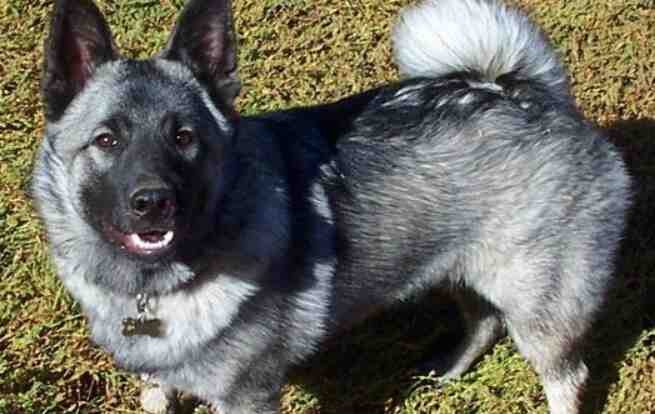Norwegian Elkhound
IUCN
LCBasic Information
Scientific classification
- name:Norwegian Elkhound
- Scientific Name:
- Outline:Carnivora
- Family:Canidae
Vital signs
- length:50-52cm
- Weight:20-23kg
- lifetime:12-15year
Feature
An assertive guard dog, but generally friendly, with a very noble and independent character. Works by scent.
Distribution and Habitat
Originated from Norway
Appearance
The ears are broad between, wedge-shaped, firm and dry (without loose skin). The eyes are very dark brown, medium in size, oval and not protruding. The ears are set high, firmly erect, but very mobile. They are fairly small, slightly higher than they are wide at the base, and pointed (not rounded) at the end. When alert, the ears are turned forward, with the outer edges vertical. When relaxed or showing a friendly attitude, the ears are laid back. When viewed from the side, the forehead and back of the skull are very slightly arched. The stop is not large, but well defined. The muzzle, when viewed from the side and above, is thick at the base, tapering smoothly and not pointed. The bridge of the nose is straight, parallel to the skull and the same length as the skull. The mouth is tightly closed. The bite is scissor-like. The neck is of medium length, muscular, well set, slightly arched, and there is no loose skin at the throat. The back is straight and strong from the withers to the s
Details
The Norwegian Elkhound is a companion of the Nordic Vikings, the guardian of the lonely manor ranch, protecting livestock and poultry from attacks by bears and wolves, and accompanying Nordic hunters on hunting tours.

The Norwegian Elkhound originated in the 9th to 12th centuries. The Scandinavians in Northern Europe bred the Norwegian Elkhound, which was highly obedient and had a majestic appearance. From then on, this dog became their indispensable hunting dog and companion dog. As for the original ancestor of the dog, it may have been a favorite dog of the Norwegian natives in ancient times. Dog bones can also be seen in some Viking graves. From ancient times to the present, the evolution and bloodline of the Norwegian Elkhound have not been interfered with by humans, so this kind of dog is generally pure.
A century ago, a British athlete Lloyd, who was also a good hunter and keen on writing, was obsessed with recording Norwegian bear hunting in his articles. It was from then on that people learned about the Norwegian Elkhound from his works and praised it. Later, bears were almost extinct in Norway, so they were mainly used to hunt elk. The Norwegian Elkhound has extremely keen senses and intuition. They can track prey 15 to 25 kilometers by smell or detect the calls of elk far away by hearing, and warn the owner while chasing. The Norwegian Elkhound is suitable for hunting many quadrupeds and soon became a master at hunting bobcats, mountain lions, and raccoons. Mr. Henry Bottinger claims that it is also an excellent fox hunter, and some people also believe that this hound can be used as an assistant to hunt mountain birds and other jungle birds.
In the long-term cooperation with people in the hunting activities, the Norwegian Elkhound has become an extremely good all-rounder. The Norwegian Elkhound was first shown to the world at the dog show in 1877, and it was recorded in the "Stud Dog Manual" and published by the Norwegian Elkhound Association. The various indicators of this dog were thus established. Before this standard was introduced, there were different standards in many countries, which made the indicators confusing, but if we study the photos of this dog in the "Stud Dog Manual", we can understand all the basic reasons for its modern ornamental dog. Although this breed of dog has not developed into a large population, it has achieved unprecedented development to a certain extent at the beginning of this century due to the contributions of many dog breeding experts. When the Norwegian Kennel Club formulated a policy of annual dog shows, the Norwegian Elkhound entered the Norwegian ornamental dog world. Since then, the number of this breed of dog has been increasing day by day. Its friendly temperament, intelligence and loyalty, absolute reliability, enthusiasm and quietness, sensitivity and fearless self-confidence have won it wide acclaim around the world, and it has become a companion for people with its outstanding hunting dog talent.
Protect wild animals and eliminate game.
Maintaining ecological balance is everyone's responsibility!








